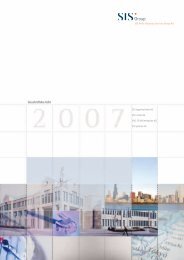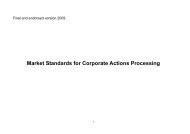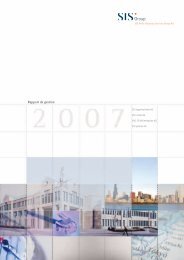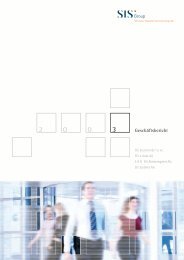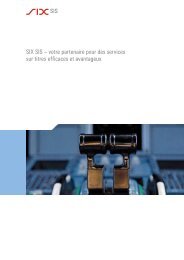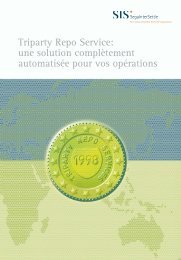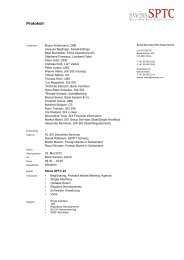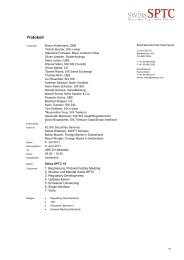Elimination of Giovannini Barrier One Final Protocol recommendation
Elimination of Giovannini Barrier One Final Protocol recommendation
Elimination of Giovannini Barrier One Final Protocol recommendation
Create successful ePaper yourself
Turn your PDF publications into a flip-book with our unique Google optimized e-Paper software.
<strong>Giovannini</strong> <strong>Barrier</strong> <strong>One</strong> – <strong>Final</strong> <strong>Protocol</strong> <strong>recommendation</strong><br />
Space 1<br />
Pre-trade/<br />
Trade<br />
Space 2<br />
Post Trade/<br />
Pre-Settlement<br />
Space 3<br />
Clearing &<br />
Settlement<br />
Trade date<br />
Trade date + X<br />
Institutional (buy) side<br />
IMI<br />
Order<br />
VMU /<br />
ETCP<br />
Area <strong>of</strong><br />
GC<br />
SC mandatory<br />
<strong>Protocol</strong><br />
usage<br />
4.4.2 Instrument scope<br />
B/D<br />
SA<br />
Central Depositories<br />
Street (sell) side<br />
Trade<br />
Exchange<br />
CCP<br />
Non trade-related activity<br />
Space 4<br />
Asset Servicing<br />
B/D<br />
SA<br />
Diagram 3: <strong>Protocol</strong> impact area<br />
1<br />
2<br />
3<br />
Cash Clearing<br />
systems/<br />
Central Banks<br />
From the original <strong>Giovannini</strong> report, the instruments in scope are clearly equities, fixed income and<br />
exchange traded derivatives. As clearing and settlement <strong>of</strong> exchange traded funds occurs in the same<br />
way as equities, they are also considered to be in scope. Non-exchange traded funds, over the counter<br />
(OTC) derivatives and commodities have not been explicitly considered in this paper, although<br />
implementation <strong>of</strong> the <strong>Protocol</strong> in these sectors is actively encouraged.<br />
4.5 <strong>Protocol</strong> terminology<br />
4.5.1 <strong>Protocol</strong><br />
For the purposes <strong>of</strong> this document, the <strong>Protocol</strong> has been defined as a set <strong>of</strong> best practice rules governing<br />
communication procedures between any two counterparties. This includes a data standard and syntax<br />
and a number <strong>of</strong> technology elements associated with the transfer <strong>of</strong> data.<br />
4.5.2 Data standard<br />
Within this <strong>Protocol</strong>, a data standard is defined as having four components:<br />
• A single agreed business process model<br />
• A single data dictionary <strong>of</strong> agreed business data elements and their definitions<br />
• A catalogue <strong>of</strong> messages developed using agreed data elements and syntax<br />
• A set <strong>of</strong> agreed market practices, where relevant.<br />
The <strong>Protocol</strong> recommends (see Section 5) the concurrent use <strong>of</strong> ISO 15022 and ISO 20022 as standards<br />
for the EU clearing and settlement industry.<br />
The four elements identified above are stored in the ISO 20022 Repository, where they are available for<br />
inspection and use by all participants in the global financial services industry, confirming the drive <strong>of</strong> the<br />
Gio_<strong>Barrier</strong>1_<strong>Protocol</strong>Recom_v2.doc Page 9



